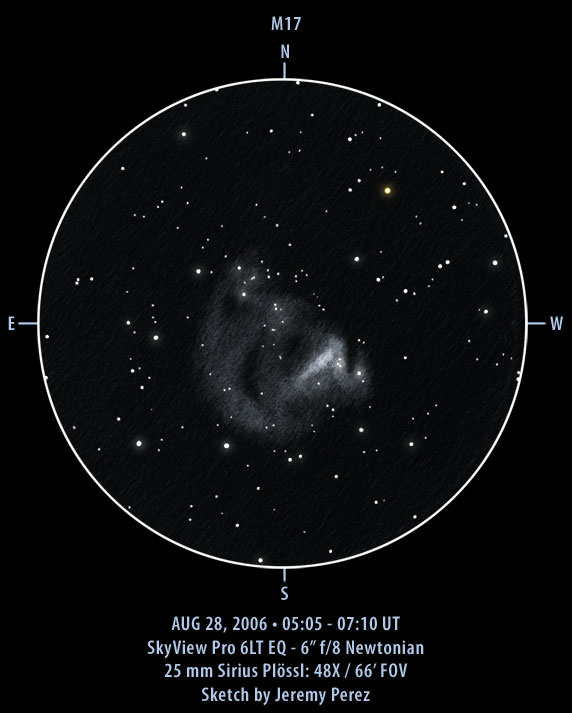
M17 – The Swan Nebula
By Jeremy Perez
Observation Notes:
From Anderson Mesa, this nebula appears much larger than the typical swan shape that I see from home. The back of the swan is the brightest portion with the neck second brightest. The head appears to have a crest, and fainter wings appear above the body. The tail flows out to the southeast and then in multiple flowing arcs to the northeast and back around to the northwest.
I chose the 25 mm Plössl eyepiece to capture the full extent of nebulosity in its 66 arc minute true field of view. There was a bright yellow-orange star to the northwest of the nebula as shown in the image. This sketch took 2 hours to complete, but the sky was clear and the experience was enjoyable. My only concern was that it would sink too far into the murk in the southwest before I finished. 172 stars are plotted in the sketch.
I used 2H and HB graphite leads to plot the stars, and a blending stump loaded with graphite to shade in the nebula. After scanning and inverting the sketch I used a soft, mostly transparent brush to add a bit of glare around the brighter stars and added color to the yellow-orange star on the northwest side of the view.
Object Information*:
M17 is a region of star formation that shines by excited emission of light from radiant young stars within. The stars that heat and illuminate this nebula aren’t readily visible, but are hidden within. It is estimated that a small cluster of about 35 of these stars are imbedded in the nebulosity.
Photographically, the color of the Swan Nebula is reddish. This color comes from the hot hydrogen gas excited to shine by the hottest stars which have just formed within the nebula. However, the brightest region is actually a white color. This white color isn’t just a photographic overexposure as I had thought, but is apparently a result of a mixture of red emission light, together with reflections of the bright star light from the dust in that region. The nebula also contains a large amount of dark obscuring dust, which is responsible for giving it its distinctive shape. However, even this dark dust is glowing brightly in the infrared spectrum, heated by hidden young stars.
The bright portion of the nebula extends roughly 15 light years, but the total cloud seems to extend at least 40 light years. The amount of matter in the cloud is estimated at about 800 times that of the Sun, which makes it more massive than the fantastic Orion Nebula (M42). It’s estimated that M17 is 5,000 to 6,000 light years away. It was discovered by Philippe Loys de Chéseaux in 1745-46, but wasn’t widely known, and so rediscovered by Charles Messier in 1764. Under very favorable conditions, M17 is just visible to the naked eye.
This object is known by a number of common names: Swan, Checkmark, Horseshoe, Omega. It is also catalogued as: Cr 377, Lund 827, LBN 60, Sh2-45, h 2008, GC 4403, OCL 44.
Very nice sketch indeed Jeremy! The rich star field just adds a great backdrop to this spectacular nebula.
~WadeVC
Jeremy,
You probably already known this but from badly light polluted observing sites the view you have sketched here cannot be matched even with an 18 inch scope. The beauty is in your fine detail.
Frank
Wade and Frank, thank you. The Anderson Mesa site really works wonders for any aperture of telescope and I know I’m fortunate to have close access to it. From my front yard, only the bright swan shape is visible. The soft, faint, northeastern tendrils of nebulosity are probably conveyed a bit too obviously in the illustration, but I wanted to be sure they showed up well on various LCD and CRT monitors. Thanks very much for your thoughts!
Jeremy